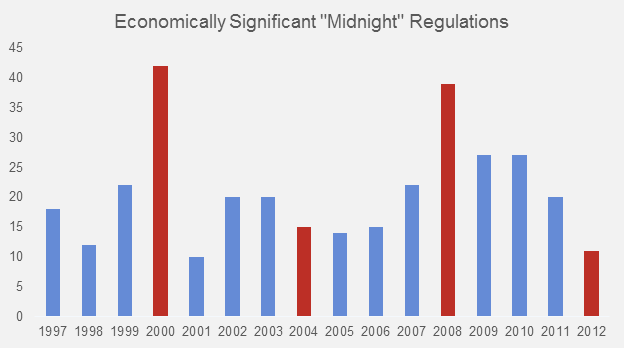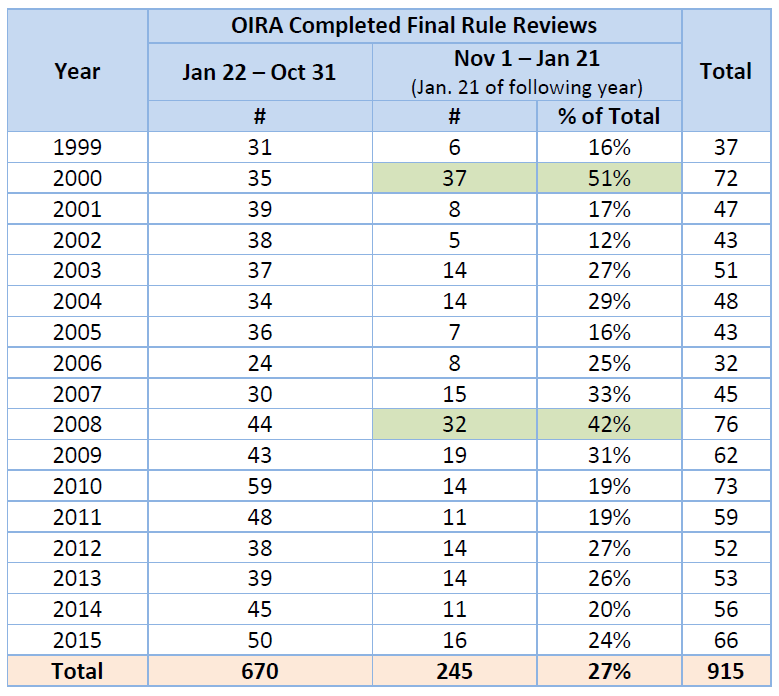Insight
July 21, 2016
On Midnight Regulation: Public Citizen Ignores the Facts
This week, Public Citizen, a progressive public interest group, released a paper purporting to show some regulations take years to complete. This is true. Unfortunately, they repackaged that message under the fallacious assumption that “midnight regulation” is a myth. Regulatory activity does increase notably during the midnight period, defined as either November 1 to January 31 during a presidential transition or any time after Election Day, but before the following inauguration. Public Citizen’s report contains a misleading and flawed methodology, selection bias, and conflates the issue of regulatory delay with a surge in midnight activity.
Increase in Activity
That outgoing presidents increase activity to cement as much of their domestic and international policy as possible is not controversial. Even the White House acknowledges this as a potential problem. The Administrative Conference of the United States has acknowledged the problem of midnight regulation, noting, “There has been a documented increase in the volume of regulatory activity during the last months of presidential terms.” The consensus in the academic literature has found that throughout the decades (from the Carter Administration and as far back as 1948), outgoing administrations finalize as many priorities as possible:
“Regulations during the post-election quarter . . . increase roughly 17 percent, on average, over the volumes prevailing during the same periods of non-presidential election years.”
Here is some recent data in graphical form. Red represents presidential election years, and the two spikes (not surprisingly) depict years where there was a change in the party composition in the White House.
Even Thomas Jefferson had problems with the midnight actions of his predecessor. Yet, faced with this overwhelming evidence, academic, think tank, and government consensus, Public Citizen unfortunately conflates the issue of regulatory delay with increases in midnight regulatory activity. In one chart on page ten of its report, Public Citizen demonstrates that the problem of “midnight regulation” is not a myth.
Notice, during the two (and only two) midnight periods the group studied (2000 and 2008), there was a 616 percent and 213 percent increase in completed final rules in the midnight period, compared to the prior year. This is the whole point of midnight regulation. Statistically, outgoing administrations regulate more when the other party is about to take the White House. The statistics above, and their implications, were never discussed in the Public Citizen report. Instead, the group talked about delayed rulemakings (also real), and even on that front, tripped over itself multiple times.
The Methodology
Perhaps the most egregious component of the entire report is its methodology. First, there is a debate over what constitutes the life of a rulemaking. It is entirely defensible to use the initial publication in the Unified Agenda. Public Citizen failed at even that. Instead of using the first publication, it just arbitrarily decided to take the Unified Agenda date and subtract three months. Ok. Why not four months? Why not five?
This is arbitrary, but perhaps justifiable. What isn’t is making up dates for the Unified Agenda publication. Public Citizen assumes they are published every year on April 1 and October 1. They are not. The spring agenda has been published as early as April 4, but as late as July 3. There have been four fall agendas published in December, not October. Why the group didn’t simply go to the preamble of each agenda and determine the date is a question they don’t address. Here is a screenshot of the publication date from the Fall 2011 agenda, clearly not reading October 1.
These omissions severely skew the rulemaking timelines. For example, assuming all new regulations commenced three months prior to the spring 2013 agenda assumes a January 2013 start. However, that agenda wasn’t released until July. So, even under Public Citizen’s methodology, the start date for 2013 regulation should have been April, the difference of an entire quarter. Public Citizen never discussed this major discrepancy. Arbitrarily adding three months to rulemaking timelines is one problem; failing to do the research on actual publication dates skews the entire dataset. Because Unified Agendas are published after April 1 and October 1, all of the rulemaking lives are arbitrarily extended in the paper.
Selection Bias
One hallmark of “rushed” rulemakings is the publication of a final rule before the initial publication in the Unified Agenda. This happens more frequently than Public Citizen might like to admit, which is perhaps why they excluded rules with short to “negative” rulemaking timelines from their dataset. As they wrote, “This occurred because the rules’ completion dates were listed as occurring more than three months prior to the rulemakings’ first appearance in the Unified Agenda. Their rulemaking lengths are not included in this analysis.”
Yes, including a zero or a negative number would have depressed the rulemaking lengths, so Public Citizen disregarded the data that didn’t fit their narrative. For example, the Obama Administration has issued at least 12 economically significant final rules before first giving public notice in the Unified Agenda. Since 2005, there have been at least 22 of these “negative rulemakings.” To exclude them is to ignore the problem of midnight regulation. These rules, by definition, are rushed through the process before the public is notified of their timelines. For every rule that takes ten years to complete, there are three that provided little to no notice at all.
The problem is even more widespread at independent agencies, although not in Public Citizen’s report. In its short time, the Consumer Financial Protection Bureau (CFPB) has already published 18 rules before first publishing them in the agenda. Here’s how excluding these rulemakings skews the data: the average life of a CFPB rulemaking (measured from first publication in the agenda to final publication in the Federal Register) is 197 days. The average, excluding these “negative” rulemakings, jumps to 376 days or a 90 percent increase in the perceived life of a rulemaking.
Fast Turnarounds
Public Citizen spent considerable time on an efficiency rulemaking for washers during the 2000 midnight period. This rulemaking existed before 2000, so it’s life did extend earlier, but the proposed rule was issued on October 5, 2000. By December, 63 days later, the agency claimed it had received and processed comments, leading to final publication by January 12, 2001. From proposed rule to final rule, this rulemaking took 97 days. As Public Citizen acknowledged, “The Clean Power Plan comment period was just over five months.”
Again, the point isn’t that rulemakings take time to complete, sometimes unnecessarily, but that there are incentives to finalize as many rules as legally possible during this midnight period. This efficiency rule for clothes washers took 97 days to go from proposed to final. By comparison, the average efficiency rule in 2016 was under review for an average of 157 days. The challenge shouldn’t be to demonstrate that some rulemaking timelines are long, but to find other significant rules that take less than 100 days to complete during the non-midnight period. Other than transfer rules, the list is short.
In sum, Public Citizen’s report doesn’t attempt to rebut the uptick in rulemaking activity during the midnight period. Scholars, government officials, and those involved in the regulatory process all acknowledge the phenomenon of midnight regulation. Instead, the group focused on the length of rulemakings and did so by excluding data, creating arbitrary timelines, and inaccurately reporting Unified Agenda data.













